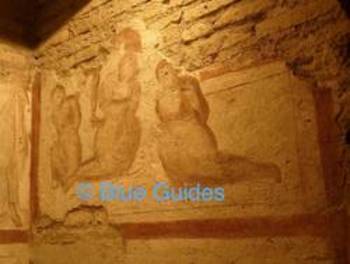Under the church of Santi Giovanni e Paolo on the Caelian Hill in Rome are the excavations known as the Case Romane (‘Roman houses’; www.caseromane.it). What has been revealed is complex and fascinating and spans at least five centuries. Traces of a wealthy domus with a nymphaeum, a street and shops, an early Christian oratory. Many of the walls still preserve their painted decoration, some of it figurative, some in the form of faux marble cladding. The church takes its name from two mid-fourth-century courtiers of the emperor Constantine II. Under his successor Julian the Apostate, who attempted to reverse the Christianisation of the empire, Giovanni and Paolo were put to death for their faith. The so-called confessio, which is approached up an iron stairway, has a fragmentary fourth-century fresco showing three kneeling figures, apparently blindfolded and awaiting execution. They are identified as Saints Priscus, Priscillian and Benedicta, ‘priest, cleric and pious lady’, who are said to have attempted to locate the remains of Giovanni and Paolo and who were arrested and executed in about 362. According to tradition, they were beheaded. Their feast day in the Roman martyrology is January 4th. This is the earliest-known depiction of a martyrdom in Christian art.

For more on this and related subjects, see Pilgrim’s Rome, published earlier this year.






